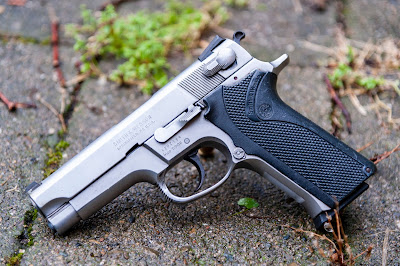When Smith & Wesson got back into the centerfire autoloader game about a decade after WWII, they only offered the pistol in one chambering. They could call it the "9mm" because in 1955 it was the first commercial domestically-produced autoloader purposely designed around the 9x19mm cartridge (Colt's contemporaneous 9mm Commander was just a Government Model with an alloy frame and three quarters of an inch whacked off the barrel.)
When Smith shifted from romantic model names to prosaic model numbers in 1957, the 9mm pistol became the "Model 39". Through the first generation of Smith's modern hammer-fired autos and well into the second, the self-loading pistols were only offered in 9x19mm*.
In fact, it wasn't until 1985, nearly at the end of the era of the three-digit Second Generation autos that Smith released one in something other than 9mm: The Model 645, a double-action challenger to the Colt Government Model. It was a honkin' big pistol with a DA trigger, hammer-dropping safety, five-inch barrel, and a size and bulk that actually slightly overshadowed the classic 1911.
After only a couple years' production, the Third Generation autos supplanted the Second in 1988. The Model 4506 was the full-size replacement for the Model 645, and it was joined in the catalog in 1990 by the Model 4516. The 4516 had a 3.75" barrel and was obviously intended as a compact challenger to Colt's diminutive Officer's ACP, which had hit the streets in 1985.
The problem was that, being constructed entirely of stainless steel, the 4516 was brick heavy at nearly thirty-eight ounces.
Enter the Performance Center, in those days still helmed by Paul Liebenberg and functioning as a limited production hand-built custom shop. In 1996, a small run of "Shorty .45" pistols were sold through distributor Lew Horton, capitalizing on the success of earlier runs of Performance Center Shorty .40 guns.
SKU #170075, labeled as a "4513" on the box, was a 3.5" single stack subcompact .45ACP. It had a hand-fitted titanium barrel bushing, hand-fit frame and slide, hand-tuned action, single-sided hammer-dropping safety, and 7-round magazine. Unlike the similarly-sized 4516, it had an alloy frame with 20lpi checkering on the frontstrap, and this difference between the two pistols knocked a full ten ounces off the gun's weight. The pictured example weighed just over 27oz. on my postal scale.
Lew Horton ordered 662 of the Shorty 45's in 1996 and they had an MSRP of $1145.95. The pictured example was bought in 2020 in used condition in the original Doskocil case with two magazines at my local gun store for $550.
*Well, and .38 Special... Hopefully I'll someday be able to do that Sunday Smith!

























